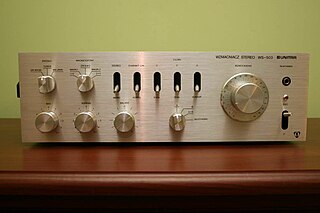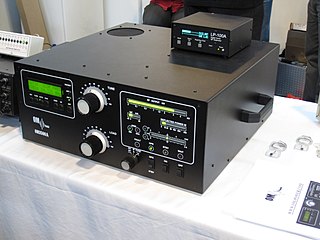This biography of a living person needs additional citations for verification .(January 2012) (Learn how and when to remove this template message) |
Bruno Putzeys (1973, Brussels, Belgium) is an audio engineer. [1]
This biography of a living person needs additional citations for verification .(January 2012) (Learn how and when to remove this template message) |
Bruno Putzeys (1973, Brussels, Belgium) is an audio engineer. [1]
He graduated cum laude at the National Technical School for Radio and Film on the subject of power stages for switching audio amplifiers. Worked for 10 years at the Philips Applied Technologies Lab in Leuven, Belgium, where he developed various digitally and analogue controlled class D amplifiers, noise shapers and modulation methods, and invented among others the "UcD" class D circuit.
In 2005 he left Philips to divide his time between Grimm Audio and Hypex. Current activities include designing high-performance discrete AD/DA converters and analogue signal processing circuits, DSP algorithms, class D power amplifiers and switch-mode power supplies. He holds several patents in the fields of digital audio and power conversion and has published extensively in these and related domains. In 2014 he co-founded Kii Audio to focus on the development of the Kii THREE speakers.

Analog television is the original television technology that uses analog signals to transmit video and audio. In an analog television broadcast, the brightness, colors and sound are represented by amplitude, phase and frequency of an analog signal.

An amplifier, electronic amplifier or (informally) amp is an electronic device that can increase the power of a signal. It is a two-port electronic circuit that uses electric power from a power supply to increase the amplitude of a signal applied to its input terminals, producing a proportionally greater amplitude signal at its output. The amount of amplification provided by an amplifier is measured by its gain: the ratio of output voltage, current, or power to input. An amplifier is a circuit that has a power gain greater than one.

Pulse width modulation (PWM), or pulse-duration modulation (PDM), is a method of reducing the average power delivered by an electrical signal, by effectively chopping it up into discrete parts. The average value of voltage fed to the load is controlled by turning the switch between supply and load on and off at a fast rate. The longer the switch is on compared to the off periods, the higher the total power supplied to the load. Along with maximum power point tracking (MPPT), it is one of the primary methods of reducing the output of solar panels to that which can be utilized by a battery. PWM is particularly suited for running inertial loads such as motors, which are not as easily affected by this discrete switching, because their inertia causes them to react slowly. The PWM switching frequency has to be high enough not to affect the load, which is to say that the resultant waveform perceived by the load must be as smooth as possible.

An audio power amplifier is an electronic amplifier that amplifies low-power electronic audio signals such as the signal from radio receiver or electric guitar pickup to a level that is high enough for driving loudspeakers or headphones. Audio power amplifiers are found in all manner of sound systems including sound reinforcement, public address and home audio systems and musical instrument amplifiers like guitar amplifiers. It is the final electronic stage in a typical audio playback chain before the signal is sent to the loudspeakers.
An audiophile is a person who is enthusiastic about high-fidelity sound reproduction. An audiophile seeks to reproduce the sound of a live musical performance, typically in a room with good acoustics. It is widely agreed that reaching this goal is very difficult and that even the best-regarded recording and playback systems rarely, if ever, achieve it.

Audio system measurements are a means of quantifying system performance. These measurements are made for several purposes. Designers take measurements so that they can specify the performance of a piece of equipment. Maintenance engineers make them to ensure equipment is still working to specification, or to ensure that the cumulative defects of an audio path are within limits considered acceptable. Audio system measurements often accommodate psychoacoustic principles to measure the system in a way that relates to human hearing.

A preamplifier, also known as a preamp, is an electronic amplifier that converts a weak electrical signal into an output signal strong enough to be noise-tolerant and strong enough for further processing, or for sending to a power amplifier and a loudspeaker. Without this, the final signal would be noisy or distorted. They are typically used to amplify signals from analog sensors such as microphones and pickups. Because of this, the preamplifier is often placed close to the sensor to reduce the effects of noise and interference.

A push–pull amplifier is a type of electronic circuit that uses a pair of active devices that alternately supply current to, or absorb current from, a connected load. This kind of amplifier can enhance both the load capacity and switching speed.

Naim Audio is a British hi-fi manufacturer based in Wiltshire, United Kingdom. The company was founded in 1973. Following a 2011 merger with French loudspeaker manufacturer Focal, Naim is owned by VerVent Audio Group, a French company.
A television transmitter is a transmitter that is used for terrestrial (over-the-air) television broadcasting. It is an electronic device that radiates radio waves that carry a video signal representing moving images, along with a synchronized audio channel, which is received by television receivers belonging to a public audience, which display the image on a screen. A television transmitter, together with the broadcast studio which originates the content, is called a television station. Television transmitters must be licensed by governments, and are restricted to a certain frequency channel and power level. They transmit on frequency channels in the VHF and UHF bands. Since radio waves of these frequencies travel by line of sight, they are limited by the horizon to reception distances of 40–60 miles depending on the height of transmitter station.

A class-D amplifier or switching amplifier is an electronic amplifier in which the amplifying devices operate as electronic switches, and not as linear gain devices as in other amplifiers. They operate by rapidly switching back and forth between the supply rails, being fed by a modulator using pulse width, pulse density, or related techniques to encode the audio input into a pulse train. The audio escapes through a simple low-pass filter into the loudspeaker. The high-frequency pulses are blocked. Since the pairs of output transistors are never conducting at the same time, there is no other path for current flow apart from the low-pass filter/loudspeaker. For this reason, efficiency can exceed 90%.
Hypex Electronics is a Dutch electronics company, known for its Class D audio amplifier modules. These employ a control method called UcD, invented by Bruno Putzeys and patented by Philips.

Class T was a registered trademark for a switching (class-D) audio amplifier, used for Tripath's amplifier technologies. Similar designs have now been widely adopted by different manufacturers.

Clipping is a form of waveform distortion that occurs when an amplifier is overdriven and attempts to deliver an output voltage or current beyond its maximum capability. Driving an amplifier into clipping may cause it to output power in excess of its power rating.
A radio transmitter or just transmitter is an electronic device which produces radio waves with an antenna. Radio waves are electromagnetic waves with frequencies between about 30 Hz and 300 GHz. The transmitter itself generates a radio frequency alternating current, which is applied to the antenna. When excited by this alternating current, the antenna radiates radio waves. Transmitters are necessary parts of all systems that use radio: radio and television broadcasting, cell phones, wireless networks, radar, two way radios like walkie talkies, radio navigation systems like GPS, remote entry systems, among numerous other uses.

A radio frequency power amplifier is a type of electronic amplifier that converts a low-power radio-frequency signal into a higher power signal. Typically, RF power amplifiers drive the antenna of a transmitter. Design goals often include gain, power output, bandwidth, power efficiency, linearity, input and output impedance matching, and heat dissipation.

A valve RF amplifier or tube amplifier (U.S.), is a device for electrically amplifying the power of an electrical radio frequency signal.
Cambridge Audio is a British manufacturer of high-end audio equipment. As the name suggests, it has its origins in Cambridge, England, where in the early 1960s a group of young technology graduates established a high-technology R&D and prototyping business: Cambridge Consultants.

Tube sound is the characteristic sound associated with a vacuum tube amplifier, a vacuum tube-based audio amplifier. At first, the concept of tube sound did not exist, because practically all electronic amplification of audio signals was done with vacuum tubes and other comparable methods were not known or used. After introduction of solid state amplifiers, tube sound appeared as the logical complement of transistor sound, which had some negative connotations due to crossover distortion in early transistor amplifiers. The audible significance of tube amplification on audio signals is a subject of continuing debate among audio enthusiasts.
In electronics, power amplifier classes are letter symbols applied to different power amplifier types. The class gives a broad indication of an amplifier's characteristics and performance. The classes are related to the time period that the active amplifier device is passing current, expressed as a fraction of the period of a signal waveform applied to the input. A class A amplifier is conducting through all the period of the signal; Class B only for one-half the input period, class C for much less than half the input period. A Class D amplifier operates its output device in a switching manner; the fraction of the time that the device is conducting is adjusted so a pulse width modulation output is obtained from the stage.